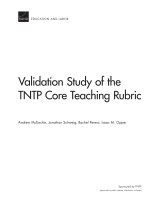| 来源类型 | Research Reports
|
| 规范类型 | 报告
|
| DOI | https://doi.org/10.7249/RR2623
|
| 来源ID | RR-2623-NTP
|
| Validation Study of the TNTP Core Teaching Rubric |
| Andrew McEachin; Jonathan Schweig; Rachel Perera; Isaac M. Opper
|
| 发表日期 | 2018
|
| 出版年 | 2018
|
| 页码 | 45
|
| 语种 | 英语
|
| 结论 |
- Relationships between teachers' TNTP Core scores and student achievement gains are modest and vary by subject area.
- Observers often disagree in their ratings of instructional practice based on the TNTP Core rubric, and these disagreements may be related to their content expertise.
- There is a considerable amount of uncertainty about the extent to which TNTP Core scores represent teachers' overall instructional practices.
|
| 摘要 |
- Consider setting higher standards for rater certification (specifically by requiring raters in training to have their scores align with those of master raters at a higher frequency).
- Research has shown that raters tend to change their approach to scoring over time — a phenomenon known as rater drift. To mitigate this, consider using more frequent post-certification calibration and validation exercises during a rating period.
- Keep in mind that high-quality evaluation and feedback require many observers with different backgrounds to rate many lessons.
- Consider collecting additional sources of evidence that support claims about the quality of teacher practice, i.e., using TNTP Core as one measure in a multiple-measure system.
|
| 主题 | Academic Achievement
; Students
; Value-Added Modeling in Education
|
| URL | https://www.rand.org/pubs/research_reports/RR2623.html
|
| 来源智库 | RAND Corporation (United States)
|
| 引用统计 |
|
| 资源类型 | 智库出版物
|
| 条目标识符 | http://119.78.100.153/handle/2XGU8XDN/108920
|
推荐引用方式
GB/T 7714 |
Andrew McEachin,Jonathan Schweig,Rachel Perera,et al. Validation Study of the TNTP Core Teaching Rubric. 2018.
|
|
文件名:
|
x1543954311967.jpg
|
|
格式:
|
JPEG
|

|
文件名:
|
RAND_RR2623.pdf
|
|
格式:
|
Adobe PDF
|
除非特别说明,本系统中所有内容都受版权保护,并保留所有权利。